– Editorial –
Self-Consolidating Concrete an Option to Increase Market Share for Precast Concrete Products
By: Cliff Ohlwiler, P.E., Cliff Ohlwiler Concrete Consulting, Inc.
By: Russell Tripp, American Concrete Pipe
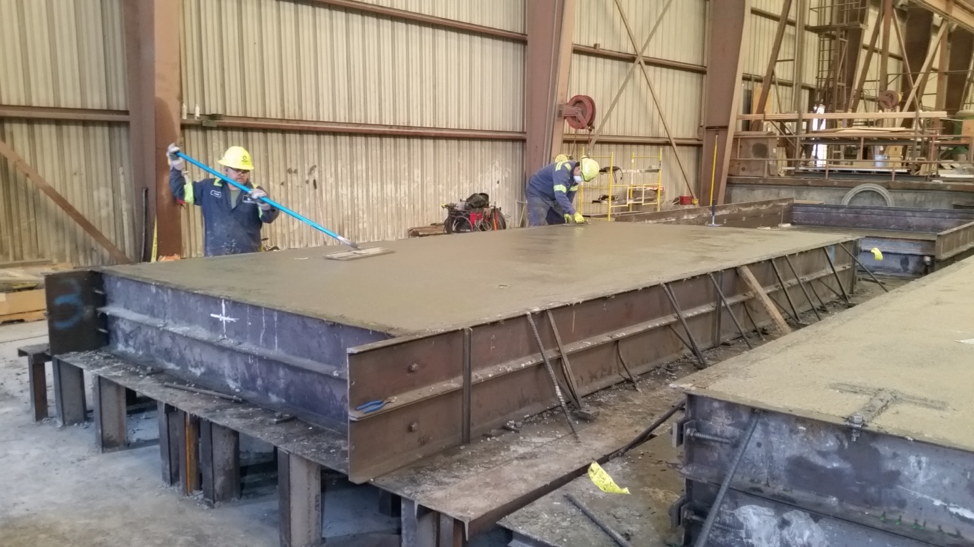 Finishing to provide a quality finish
Finishing to provide a quality finish
One of the many advances in the reinforced concrete precast box and manhole production industry is self-consolidating concrete (SCC). SCC is a highly flowable, non-segregating concrete that can flow into place, fill the formwork, and encapsulate the reinforcement without any mechanical consolidation. It is a highly engineered fluid with unique rheological properties. Rheology is the science dealing with the flow of materials, including studies of deformation of hardened concrete, the handling and placing of freshly mixed concrete, and the behavior of slurries and pastes. (Cement and Concrete Terminology, ACI Publication SP-19). The concrete mix is finding its way into many buried precast infrastructure applications. Those who recognize opportunities for SCC-based products have learned a new way of mixing concrete to increase market share in a very competitive storm sewer, sanitary sewer and stormwater management market space.
-
Continued
Many U.S. states are cautious about the use of SCC, and most do not have fully developed specifications to produce the mix, mainly due to lack of familiarity or promotion by our Industry. State DOTs, however, are becoming more interested in SCC and are beginning to work with reinforced concrete producers to develop specifications that have been adopted by municipal public works officials. Some of the state DOTs already accepting SCC in specifications are CA, MN, IA NE, ND, SD, MT, WY, KS, MO, WI, VA, NY, NJ, PA, and MD. California, Iowa and South Dakota have published specifications for SCC.
Caltrans 2015 Standard Specification section 90-5 allows SCC in precast concrete, providing the mix design has been prequalified per section 90-5.01D(2)(c) Prequalification of Mix Design. All other types of construction require approval in the special provisions, or special approval must be requested for a project.
The SCC Basics – 101
Concrete is typically considered a Bingham fluid, which is described in terms of yield stress and plastic viscosity. The yield stress is the shear stress to initiate or maintain flow and the plastic viscosity is the resistance to flow once the yield stress is exceeded. SCC should have a very low yield stress, but the plastic viscosity can vary. (Wikipedia)
The addition of superplasticizers and viscosity modifiers supplied by admixtures companies reduce viscosity and segregation. Concrete that segregates loses strength and results in lower durability and honeycombed areas next to the formwork. Admixtures companies and vendors supply increasingly complex and specialized raw materials that yield products tailored to specific construction environments and concrete production capacity. A well-designed SCC mix does not segregate and has high deformability and excellent stability characteristics. For these reasons, reinforced concrete producers enjoy the benefits of increased potential for reduced vibration and automation in precast facilities, increased worker productivity, and reduced health and safety issues related to vibration. Because the production process is improved, higher quality products are the outcome.
SCC requires concrete movement to provide consolidation. It is important to limit the number of placement locations on a form to allow concrete to flow and consolidate. Normal concrete mixes typically require placement from many closely-spaced locations to minimize concrete movement and segregation. SCC is more efficient for placement in forms containing intricate details and congested reinforcement.
The timing for finishing steps will be affected. Finishers must become familiar with the SCC mix setting characteristics to time the finishing steps and provide a quality concrete finish. Overall set time can be controlled like any other concrete with accelerators or retarders.
Quality Control
- Aggregate gradations must be closely monitored and consistent to produce SCC
- Forms must be level
- Visual Stability Index (VSI) is an easy and valuable test for monitoring mix stability but can be a subjective test
- PCI Guidelines
Guidelines for The Use of Self-Consolidating Concrete in Precast/Prestressed Concrete 2nd Edition (TR-6-15-PCI) The guidelines represent current recommended practice of using SCC in the precast/prestressed concrete industry. These guidelines address the use of SCC in precast, prestressed concrete manufacturing plants and reference PCI plant quality manuals MNL-116-99 and MNL-117-13.
- ASTM standard test methods specifically for SCC
C1758 / C1758M – 15, Standard Practice for Fabricating Test Specimens with Self-Consolidating Concrete. This practice covers procedures for fabricating test specimens in the laboratory or field using a representative sample of fresh self-consolidating concrete.
ASTM C1610 / C1610M – 17, Standard Test Method for Static Segregation of Self-Consolidating Concrete Using Column Technique provides users with a procedure to determine the potential static segregation of self-consolidating concrete. This test method is used to develop self-consolidating concrete mixtures with segregation not exceeding specified limits.
ASTM C1611 / C1611M – 14, Standard Test Method for Slump Flow of Self-Consolidating Concrete provides a procedure to determine the slump flow of self-consolidating concrete in the laboratory or the field. The test method is used to monitor the consistency of fresh, unhardened self-consolidating concrete and its unconfined flow potential.
Slump flow test
ASTM C1712 – 17, Standard Test Method for Rapid Assessment of Static Segregation Resistance of Self-Consolidating Concrete Using Penetration Test is for the rapid assessment of the static segregation resistance of self-consolidating concrete. The method is useful for rapid assessment of the static segregation resistance of self-consolidating concrete during mixture development in the laboratory as well as prior to placement of the mixture in the field. The test does not measure static segregation resistance directly but provides an assessment of whether static segregation is likely to occur. Test Method C1610/C1610M for static segregation of SCC is not sufficiently rapid, and the non-mandatory Visual Stability Index as determined through the procedure described in Appendix X1 of Test Method C1611/C1611M is highly subjective and qualitative.
ASTM C1621 / C1621M – 17, Standard Test Method for Passing Ability of Self-Consolidating Concrete by J-Ring provides a procedure to determine the passing ability of self-consolidating concrete. This test method is applicable for laboratory use in comparing the passing ability of different concrete mixtures. It is also applicable in the field as a quality control test.
Daily plant quality control testing similar to Caltrans requirements is a suggested minimum. This would include Slump Flow, Visual Stability Index (C1611) and Compressive Test Specimens (C1758). Combinations of the other tests can be used to evaluate characteristics of mix designs.
Safety improvements with SCC
- Plant noise reduction (no vibrators)
- No airlines or extension cords on the floors to power the vibrators
- Personnel are not needed on the forms to handle internal vibrators
- Reduced need for personnel to guide the concrete bucket during placement
- Remote control buckets are common with SCC concrete pouring
Placement
Production cost savings with SCC
- Savings from reduced wear and tear on forms from vibration
- Savings from reduced placement labor costs and speed of placement
- Reduced costs for air hoses, vibrators and electrical extension cords
- Early stripping strengths can be obtained without the use of steam curing
Production cost increases with SCC
- Typically, higher cementitious material contents are used to increase paste volume to improve mix flow and mix stability
- SCC mixes may also have higher admixture costs
In increasingly competitive markets for precast concrete drainage systems, precasters are building the case for SCC with new applications for existing standard products. The introduction of new SCC products for sustainable drainage systems, low impact development for stormwater management, and resilient critical buried infrastructure are increasing each year. An additional option that holds opportunity for increasing market share lies in the use of self-consolidating concrete. The mix is accepted in many states, and it appears that many more are now moving to work with local producers to develop and revise specifications to include SCC. Many producers have taken advantage of the SSC mix to realized cost savings in production for improving plant safety while supplying more products to infrastructure projects.
Photos: courtesy of the ACPA and its members.
– 2018 ACPA Project Achievement Award Winner –
MDOT’s Caine Road/Goodings Creek Box Culvert Installed with Both Faces of Many Sections Tapered
By: Jim Washabaugh, Northern Concrete Pipe, Inc.
 Michigan Department of Transportation (MDOT) called for the removal of the bridge over Goodings Creek on Caine Road, Tuscola County near Vassar and replacement with a precast concrete box culvert in April 2017. Northern Concrete Pipe (NCP) was consulted to supply the box sections. NCP had manufactured box culvert segments many times with each end face tapered, but this project required a 24-foot box span with may of the sections tapered on both faces.
Michigan Department of Transportation (MDOT) called for the removal of the bridge over Goodings Creek on Caine Road, Tuscola County near Vassar and replacement with a precast concrete box culvert in April 2017. Northern Concrete Pipe (NCP) was consulted to supply the box sections. NCP had manufactured box culvert segments many times with each end face tapered, but this project required a 24-foot box span with may of the sections tapered on both faces.
NCPI could taper an end section that is 8-feet long on one end and 2.5 feet long on the other end, but for a 24-foot span box section, this would result in an approximately 12-degree skew of the end face of the end sections which was not adequate for this design.
-
Continued
This project was awarded funding through MDOT’s Local Bridge Program. Great Lakes Engineering Group, LLC (GLEG), was awarded the design phase. The project scope was for a full bridge replacement. During the initial design phase, it was determined that the potential for erosion in the southeast quadrant would control the geometry of the proposed replacement structure. There was a history of the stream eroding the roadway fill where the river turned to parallel the roadway and then turn again to go through the existing bridge. The first option was to provide a larger bridge to span over the eroded area. This approach was discarded due to limited under clearance at the location. To raise the bridge enough to fit a beam/deck structure, additional right-of-way land would be needed. At this point a three-sided culvert was analyzed. A 36-foot span, three-sided flat top culvert was designed which would allow the stream to flow diagonally through the proposed structure. The structure could not be extended outside the road right of way or skewed enough to meet requirements, therefore the longer span was required. The Michigan Department of Environmental Quality (MDEQ) did not object to this approach, but it was not their preferred method for the crossing. The three-sided culvert option, however, required a substantial number of piles to resist the horizontal forces of this structure type given the long span and short rise. The additional span length and pile costs pushed the project costs well outside the project funding.
The question remained, how far a 24-foot span box section could be skewed on each face and remain constructible. NCPI could take 5 degrees off the face of a box section. Given that an approximately 45-degree crossing was needed, 5 degrees at each end would not be enough. The engineer then drew box sections with 4-degree skews taken off both of the section faces. Moving the skew face to a joint would double the angle per joint allowing 8 degrees per joint. A 45-degree crossing could be achieved 8 degrees at a time and back. A box culvert with a reverse curve of sections was laid out which intercepted the channel at the upstream end before the curve in the stream which was causing the erosion and provided an outlet in line with the existing bridge outlet, all within the 66-foot road right of way. MDEQ agreed to try the snake-looking concept, if it passed the hydraulics requirements. GLEG proceeded with hydraulic calculations, permitting, and design. The estimated project cost was reduced as compared with the three-sided culvert option and was within the funding authorized.
The original design called for a 16-inch thick top slab and a 14-inch thick bottom slab to meet the loading requirements of MDOT’s HL-93 Modified Loading. NCPI decided to use a 16-inch thick top and bottom slab to make the production of these segments more efficient. By keeping the top and bottom slab the same thickness, NCPI was able to set up the custom form once, which took a couple of additional days from normal set up time for the fabrication department. A change to the orientation of the top and bottom reinforcing mats, and switch of the lifting holes that get cast through the top slab for setting the sections into place from one side to the other, allowed NCPI to make the right and left hand turns of the radial sections. The fabrication time of each reinforcing cage took several hours more than a standard box cage and three or four people. The required steel reinforcing areas were significantly large due to the long span of the section, along with meeting the requirements of MDOT’s HL-93 Modified loading (this is based upon 1.2 times the current AASHTO LRFD bridge design specification HL-93 loading with the exception that the design tandem portion of the HL-93 load definition is replaced by a single 60 KIP axle load before application of this 1.2 factor). Assembling these extremely heavy reinforcing mats was time-consuming. What added to the difficulty of the task, was the 4-degree taper on each face of the cage that had to be laid out, then cut from each end, while keeping all dimensions within the allowable ASTM tolerances.
A 3-foot wide x 3-foot tall precast footing was provided at each end of the box run to prevent scour. They were manufactured in two sections per end, which ran from the center line of the end box sections out to the ends of the precast wingwalls. The precast wingwalls were manufactured with T-shaped earth anchors attached to the back side. The top of each wingwall matched the top of the 12-inch x 12-inch precast headwalls which were attached to both end sections of the box run. The wingwalls were tie-plated to the end box sections with 1-inch thick galvanized steel plates and bolted into threaded anchors which were cast into the end box sections, as well as the back side of each wingwall. The wingwalls were installed and attached after all box sections were set in place.
The project design was completed utilizing the reverse curve/snake concept and utilized precast footings, headwalls and wingwalls to allow for flexibility if any fit-up issues arose during construction. All precast box sections were installed in twelve hours within the awarded funding during summer.
Photos: courtesy of the ACPA and its members.
Bridge Replaced with Four-Cell Precast Concrete Box Culvert Using Accelerated Precast Construction Method
By: Hancock Concrete Products LLC
Project Need North Dakota Department of Transportation (NDDOT) is developing a new transportation system in western North Dakota to accommodate the state’s agriculture sector and an emerging energy industry. Upgrading Highway1804 two miles north of New Town included replacement of a bridge. The first option was a precast concrete box culvert and the second a cast-in-place (CIP) box culvert. Both options accommodated a wide clear zone to eliminate guard rails allowing snow to blow across the highway without being trapped. The benefit is reduced snow removal and improved highway safety. No bids were received for the cast in place option.
Click on photo for complete article.
– Article – Concrete Pipe –
Reconstruction of WisDOT West Waukesha Bypass Ensures Safer Driving and Resilient Pipeline Systems and Culverts
By: Cyle Cramer, County Materials Corporation
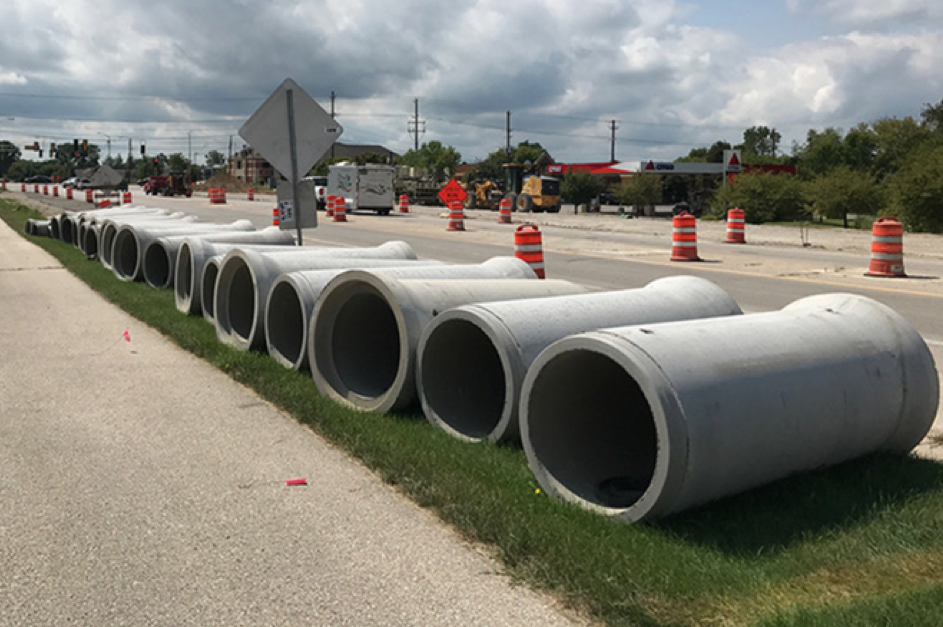 Lack of a major road connecting Interstate 94 and Highway 59 in Wisconsin led motorists to use several smaller streets in City of Waukesha for their commute, causing frequent traffic jams and unsafe conditions. After a by-pass alignment was approved, the City teamed with Waukesha County and the Wisconsin Department of Transportation (WisDOT) in 2015 to design and build a four-lane bypass with a raised median along most of the length of Merrill Hills Road and Meadowbrook Road. The project brought three levels of government together and required the concrete pipe manufacturer, County Materials Corporation, to supply massive amounts of precast concrete materials from three manufacturing locations for flood mitigation on the City and County portions of the project. In addition, County Materials supplied precast products for culverts on several creeks and tributaries that flow under the bypass in areas constructed by the County and WisDOT. Waukesha was responsible for a three-quarter mile alignment from Rolling Ridge Drive to North View Road. Waukesha County was responsible for the 1.3-mile alignment from Northview Road to U.S. Highway 18/Summit Avenue, and WisDOT was responsible for 5 miles from U.S. Highway 18/Summit Avenue to Highway 59.
Lack of a major road connecting Interstate 94 and Highway 59 in Wisconsin led motorists to use several smaller streets in City of Waukesha for their commute, causing frequent traffic jams and unsafe conditions. After a by-pass alignment was approved, the City teamed with Waukesha County and the Wisconsin Department of Transportation (WisDOT) in 2015 to design and build a four-lane bypass with a raised median along most of the length of Merrill Hills Road and Meadowbrook Road. The project brought three levels of government together and required the concrete pipe manufacturer, County Materials Corporation, to supply massive amounts of precast concrete materials from three manufacturing locations for flood mitigation on the City and County portions of the project. In addition, County Materials supplied precast products for culverts on several creeks and tributaries that flow under the bypass in areas constructed by the County and WisDOT. Waukesha was responsible for a three-quarter mile alignment from Rolling Ridge Drive to North View Road. Waukesha County was responsible for the 1.3-mile alignment from Northview Road to U.S. Highway 18/Summit Avenue, and WisDOT was responsible for 5 miles from U.S. Highway 18/Summit Avenue to Highway 59.
-
Continued
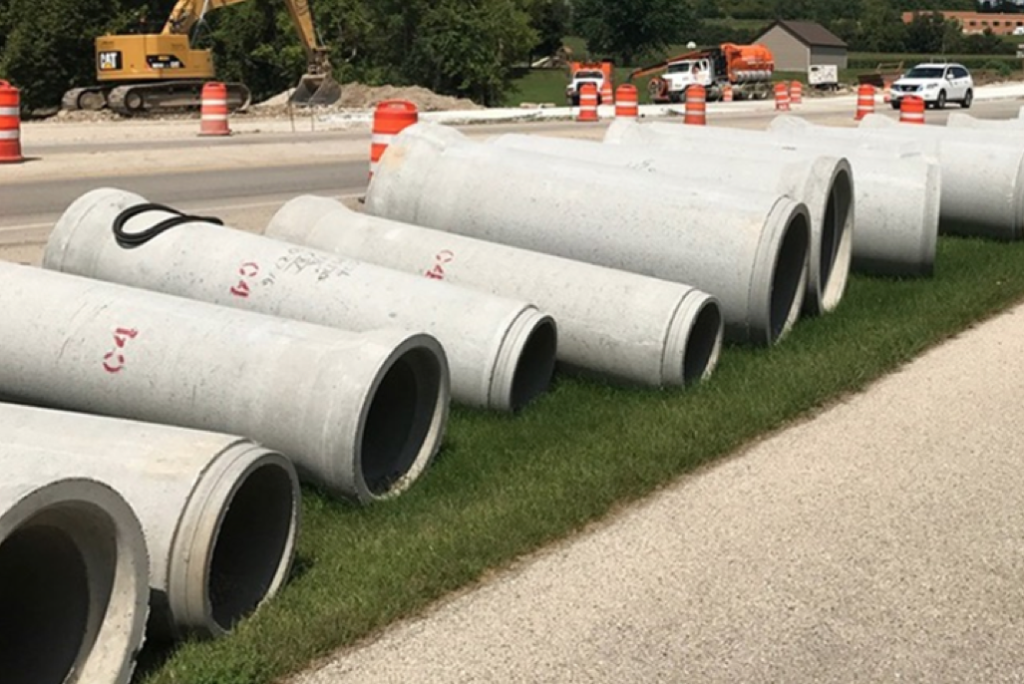
Material orders were not issued until three weeks before construction because of several design changes. Little time was left for County Materials to create structure drawings detailing special designs, receive approval from the contractor and engineer, and commence production before the projected start-date of June 12, 2017. County Materials created detailed drawings for 190 special structures, including culvert and manhole systems in just over a week. One week later, pipe and special structures began to arrive on site. County Materials’ large delivery fleet and experienced dispatch team eliminated many of the obstacles that can lead to long wait times for materials. County Materials supplied 14,518 feet of reinforced concrete pipe ranging from 12 inches to 48 inches in diameter, comprised of class III, class IV, and class V pipe, along with 33 manholes, 58 catch basins, and 157 inlets.
In addition to storm sewers, County Materials supplied 1,040 feet of class III reinforced concrete pipe and 42 apron end walls for ditch-to-ditch applications, which included installation under the driveways of several homes and businesses, and two rows of 176-foot each 60-inch diameter class III reinforced pipe to pass under the bypass to handle the flow of Fiddlers Creek.
A tributary of Pebble Creek runs under Meadowbrook Road north of Summit Ave, through three separate concrete pipe culverts. To mitigate impact on the waterway, the three agencies decided to keep the culverts in place and extend their lengths to accommodate the wider road. County Materials supplied 216 of 48-inch diameter reinforced concrete culvert pipe for two of the runs and 109 feet of 72-inch diameter reinforced concrete culvert pipe for the third. The additional length will extend to the west another 108 feet protecting the tributary from erosion. The bottom of the three culvert extensions were partially buried to maintain the tributary’s natural streambed, which is vital for water flow and health of aquatic animals.
County Materials shipped 224 truckloads of precast structures from production facilities in Rib Falls, Green Bay, and Madison. Construction on the bypass will continue into 2019.
Photos: courtesy of the ACPA and its members.
– Article – Concrete Pipe –
Gateway to the City of Fort Myers is Restored with Concrete Pipe
By: : Douglas J. Holdener, P.E., Florida Concrete Pipe Association
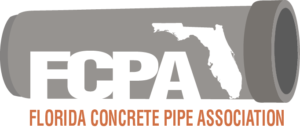
The recent restoration of a 2.2-mile section of historic McGregor Boulevard from Colonial Boulevard to Poinciana Avenue in the City of Fort Myers has been a long-awaiting solution. Most Fort Myers residents are familiar with the periodic lane closures and emergency construction over a span of a decade and a half. Most local civil engineers and civil contractors are familiar with the cause of the problems: a failing storm pipe system.
The McGregor Boulevard restoration project, officially known as McGregor Boulevard Flexible Pavement Restoration has been a true unification of a local community. Spanning nearly two decades after the initial drainage installation, McGregor Boulevard suffered from collapsing plastic storm pipes that resulted in pavement subsidence issues and warranted multiple open-cut pipe replacements.
-
Continued
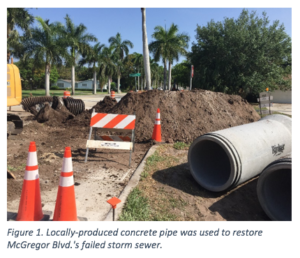 Through successful coordination with the Florida Department of Transportation (FDOT), the City of Fort Myers officials found a way to secure funding and restore the infrastructure, as well as the community. The city designed the project in-house, and the City Manager Saeed Kazemi, P.E. served as the Engineer of Record (EOR).[1] The $5.4M construction contract was awarded to Wright Construction Group, a local contractor. The concrete pipe was supplied by local producer Rinker Materials Concrete Pipe Division. Construction engineering inspection (CEI) services were performed by local engineer Paul Wingard, P.E. (KCCS Construction Services). Perhaps most importantly, the local media and the Fort Myers community were supportive of the project throughout the entire process.
Through successful coordination with the Florida Department of Transportation (FDOT), the City of Fort Myers officials found a way to secure funding and restore the infrastructure, as well as the community. The city designed the project in-house, and the City Manager Saeed Kazemi, P.E. served as the Engineer of Record (EOR).[1] The $5.4M construction contract was awarded to Wright Construction Group, a local contractor. The concrete pipe was supplied by local producer Rinker Materials Concrete Pipe Division. Construction engineering inspection (CEI) services were performed by local engineer Paul Wingard, P.E. (KCCS Construction Services). Perhaps most importantly, the local media and the Fort Myers community were supportive of the project throughout the entire process.A History of Drainage System Problems
Public Works Director Richard Moulton considers McGregor Boulevard a “Gateway to the City.” In 2018, McGregor Boulevard turns 103 years old. Named after Ambrose and Tootie McGregor, the road’s construction was completed in 1915. Tootie McGregor Terry, whom remarried after Ambrose McGregor died in 1900, privately funded the construction of McGregor Boulevard in 1912 at the estimated modern-day-equivalent sum of $300M.[2] In addition, Tootie funded the annual maintenance for five years for a section of the roadway. [3]
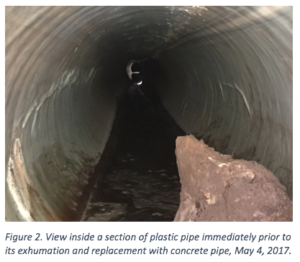 In 1923, McGregor Boulevard was designated as a state road. In 1999, the Florida Department of Transportation transferred ownership of the section of McGregor Boulevard located within the city limits to the City of Fort Myers. Subsequently, drainage pipe from Colonial Boulevard to Lynwood Avenue was replaced. [4] The pipe material used as part of the drainage construction was corrugated High-Density Polyethylene (HDPE) plastic pipe. Signs of apparent structural distress were recorded in post-installation inspection video records, dated recently after installation in 2000.[5] Over the next decade and a half, there were numerous repairs and pipe replacement projects to fix failing sections of the HDPE pipe installation and subsiding pavement.
In 1923, McGregor Boulevard was designated as a state road. In 1999, the Florida Department of Transportation transferred ownership of the section of McGregor Boulevard located within the city limits to the City of Fort Myers. Subsequently, drainage pipe from Colonial Boulevard to Lynwood Avenue was replaced. [4] The pipe material used as part of the drainage construction was corrugated High-Density Polyethylene (HDPE) plastic pipe. Signs of apparent structural distress were recorded in post-installation inspection video records, dated recently after installation in 2000.[5] Over the next decade and a half, there were numerous repairs and pipe replacement projects to fix failing sections of the HDPE pipe installation and subsiding pavement.A Robust, Permanent Solution
The Fort Myers City Council and the City Manager, Mr. Saeed Kazemi, P.E. (Public Works Director and City Engineer at the time) engaged with FDOT and secured the programmed replacement of the pavement from Colonial Blvd. to Poinciana Ave. According to the current Public Works Director Richard Moulton, the timing to ultimately replace the entire plastic pipe system, rather than continue with the periodic replacements, was spurred by a series of super-tidal events that surcharged the drainage system in the coastal impacted zones. It is believed that the surcharge events exacerbated the compromised pipe sections leading to accelerated failures of the pipe embedment and more significant pavement subsidence. What would have been a more manageable fault became more cavernous concerns due to the surcharge events.
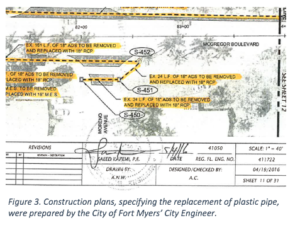 The engineering plans directed the removal and disposal of 11,672 feet of storm sewer pipe. The failing pipe was replaced with 232 feet of Elliptical Reinforced Concrete Pipe (ERCP) and 11,440 feet of 18-inch through 30-inch Reinforced Concrete Pipe (RCP). In addition to replacing the plastic pipe, the project required the milling and resurfacing of 51,400 square yards of asphalt, the installation of 18,350 square yards of pavement base and subgrade material, 8,600 yards of asphalt, and 350 tons of asphalt leveling course.
The engineering plans directed the removal and disposal of 11,672 feet of storm sewer pipe. The failing pipe was replaced with 232 feet of Elliptical Reinforced Concrete Pipe (ERCP) and 11,440 feet of 18-inch through 30-inch Reinforced Concrete Pipe (RCP). In addition to replacing the plastic pipe, the project required the milling and resurfacing of 51,400 square yards of asphalt, the installation of 18,350 square yards of pavement base and subgrade material, 8,600 yards of asphalt, and 350 tons of asphalt leveling course.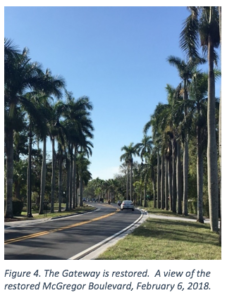 Mr. Moulton considers it a blessing that the natural super-tide events occurred in a manner that exposed the problems in the early daylight hours and that the City was prepared to ultimately replace the system with a robust, permanent solution. Mr. Moulton sees an appropriate fit for concrete pipe and plastic pipe within their work program. The City will continue to evaluate the use of appropriate piping materials consistent with is specifications and design parameters for right-of-way applications.
Mr. Moulton considers it a blessing that the natural super-tide events occurred in a manner that exposed the problems in the early daylight hours and that the City was prepared to ultimately replace the system with a robust, permanent solution. Mr. Moulton sees an appropriate fit for concrete pipe and plastic pipe within their work program. The City will continue to evaluate the use of appropriate piping materials consistent with is specifications and design parameters for right-of-way applications.[1] McGregor Boulevard Flexible Pavement Restoration from Colonial Boulevard to Poinciana Avenue, Construction Plans, City Project #411722, State Project 437137-1-58-01, Prepared by City of Fort Myers for the Florida Department of Transportation, signed and sealed by Saeed Kazemi, P.E., May 4, 2016.
[2] Bickel, Mark, McGregor the boulevard, not the fighter, packs a punch in Fort Myers history, The News-Press, August 26, 2017, http://newspr.es/2wHIvxg.
[3] City Council and Board of County Commissioners Accept Mrs. Terry’s Proposition to Construct McGregor Boulevard, Fort Myers Daily Press, page 1, February 13, 1912.
[4] City asking for state help in funding McGregor Blvd work, on-line news article, Waterman Broadcasting Corp., NBC2, August 26, 2014, http://www.nbc-2.com/story/26378108/city-asking-for-state-help-in-funding-mcgregor-blvd-work.
[5] Video inspection records, prepared by Sewer Viewer, documented as for McGregor Boulevard, dated April 2000.
– Software –
Concrete Pipe and Precast Box Software Updates
Concrete pipe and precast box software used by the ACPA, its members and the drain pipe industry has been updated and modified to be more user friendly.
 |
The ACPA app “Compare Flow” has been updated to work on the latest Android and Apple operating systems.https://itunes.apple.com/us/app/compare-flow/id581217854?mt=8
https://play.google.com/store/apps/details?id=com.Compare_Flow&hl=en |
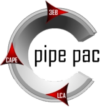 |
PipePac® has been moved to a new server.https://old.concretepipe.org/pipe-box-resources/software/pipepac/ |
 |
Eriksson Technologies has developed ETCulvert and Eriksson Pipe software for use with reinforcement designs for precast box culverts and precast concrete pipe.https://erikssonsoftware.com/#Pro6 |
– ACPA Annual Convention 2018 –
ACPA Annual Convention Celebrates a Strong Concrete Pipe Industry
ACPA’s 110th Annual General Meeting attracted some 125 people. The auction was successful raising about $225,000 for the foundation. Guest speaker Tom Everrett (FHWA) gave a presentation that addressed issues facing ACPA members.
Mark Omelaniec of the Langley Concrete Group of Companies in Langley, British Columbia Canada was elected Chair of the Board of Directors. This is his second term as Chair. Jeff Hite of Rinker Materials – Concrete Pipe Division is Vice Chair. Darren Wise was recognized for his leadership through a year of change at the ACPA and took his place among a prestigious group of Past ACPA Chairs. The entire Board of Directors is on the ACPA website.
Many members and their companies received awards and recognition for accomplishments through 2017.
ACPA extends deep gratitude to its Associate Members who continue to support and sponsor ACPA events.
The 2019 conference will be held at the Hyatt Regency, Palm Springs March 23 to 26.


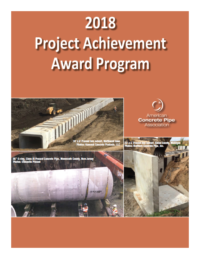
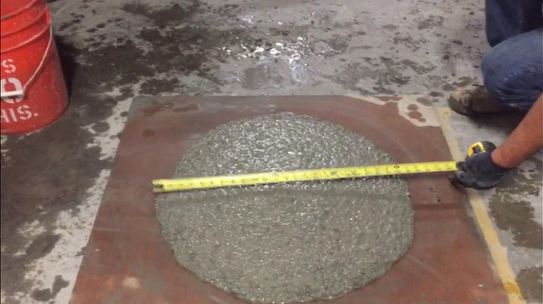
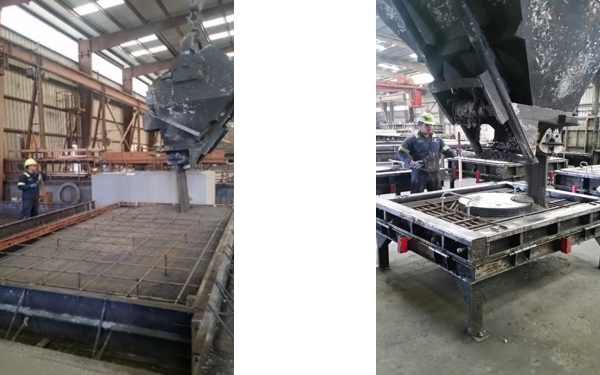
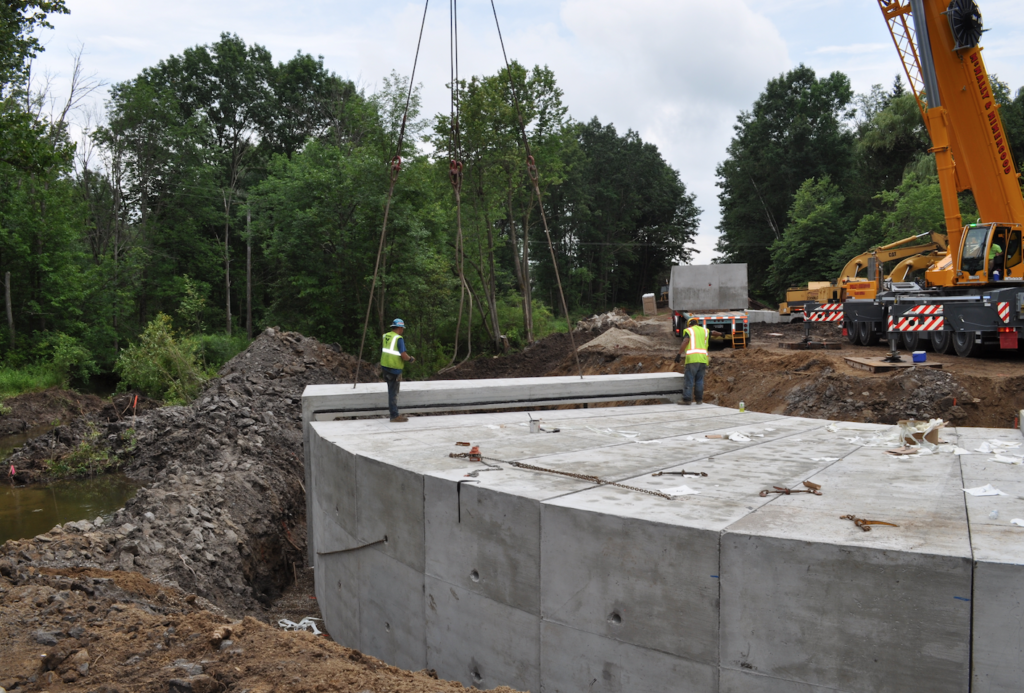
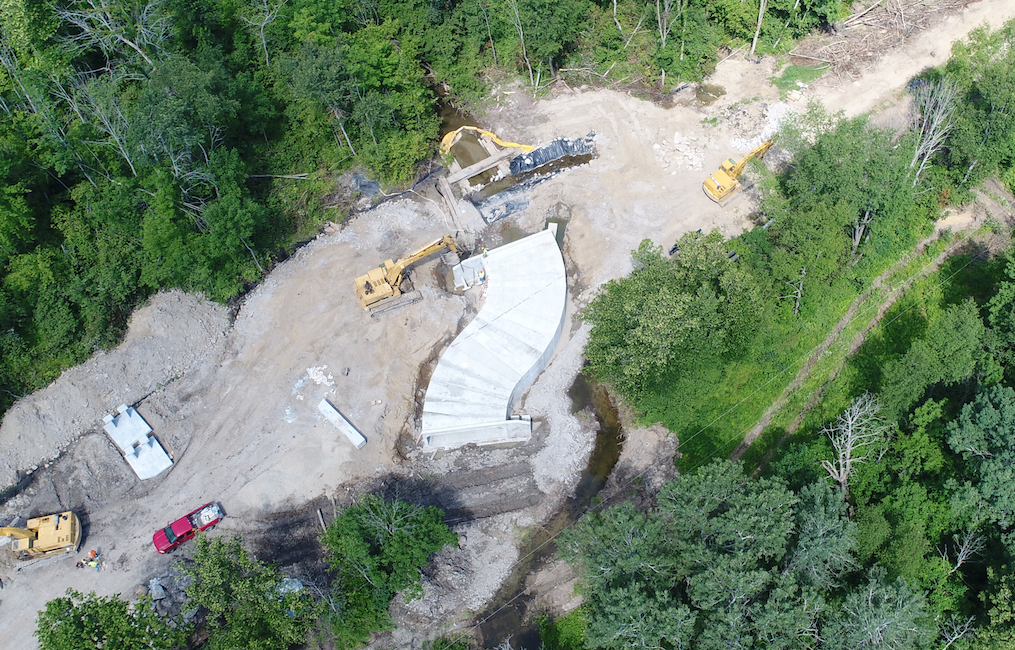
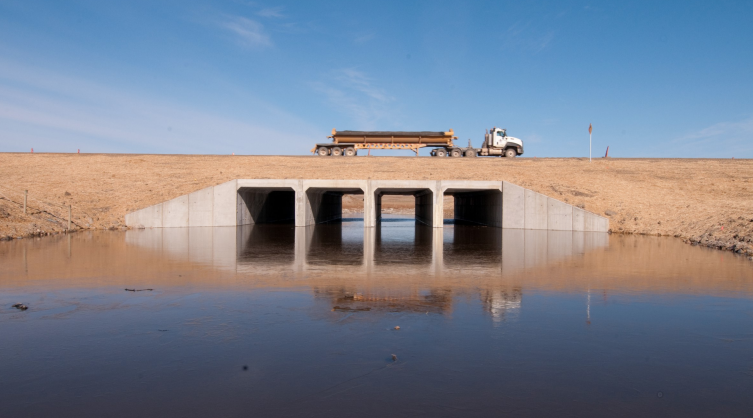
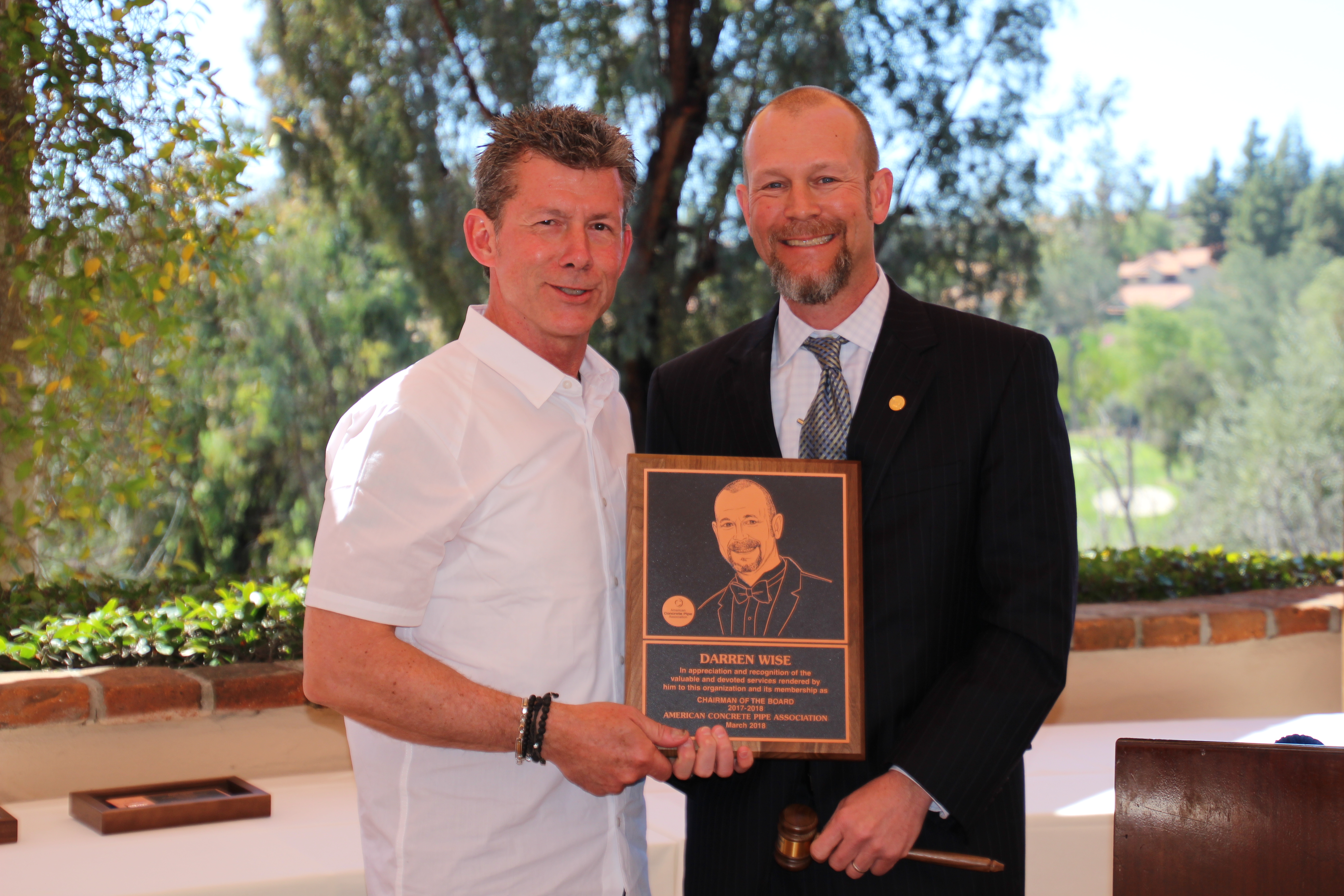
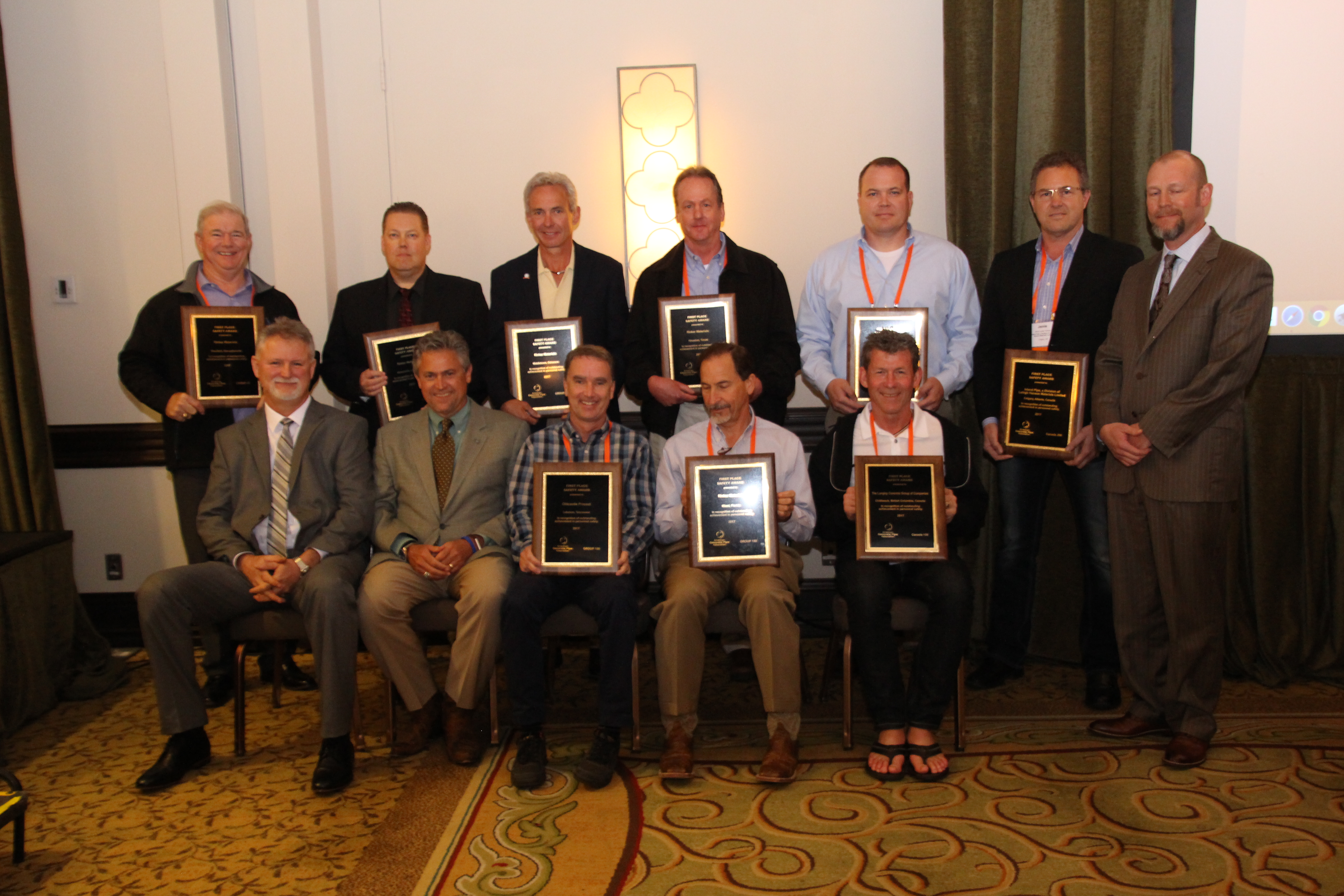
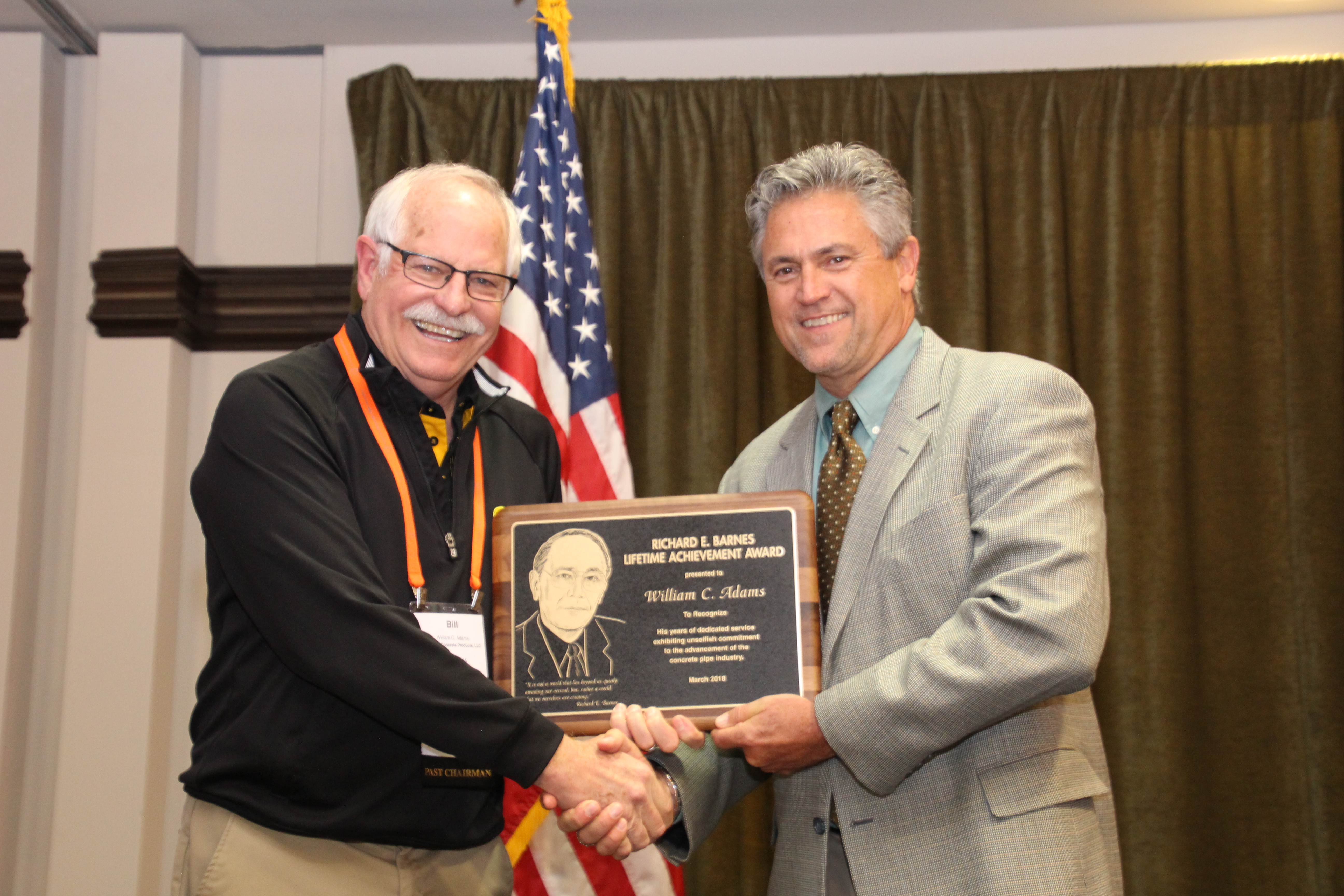
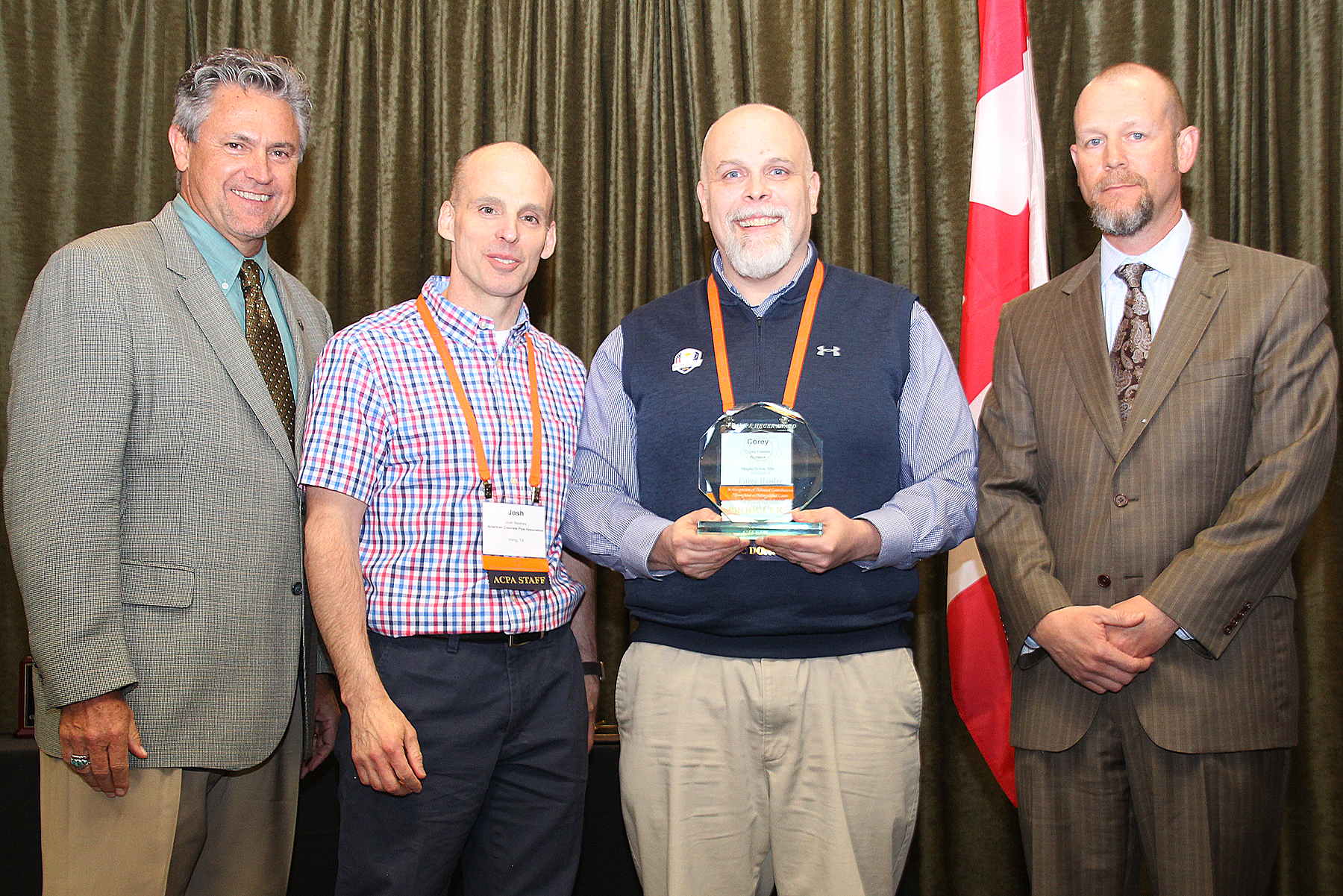
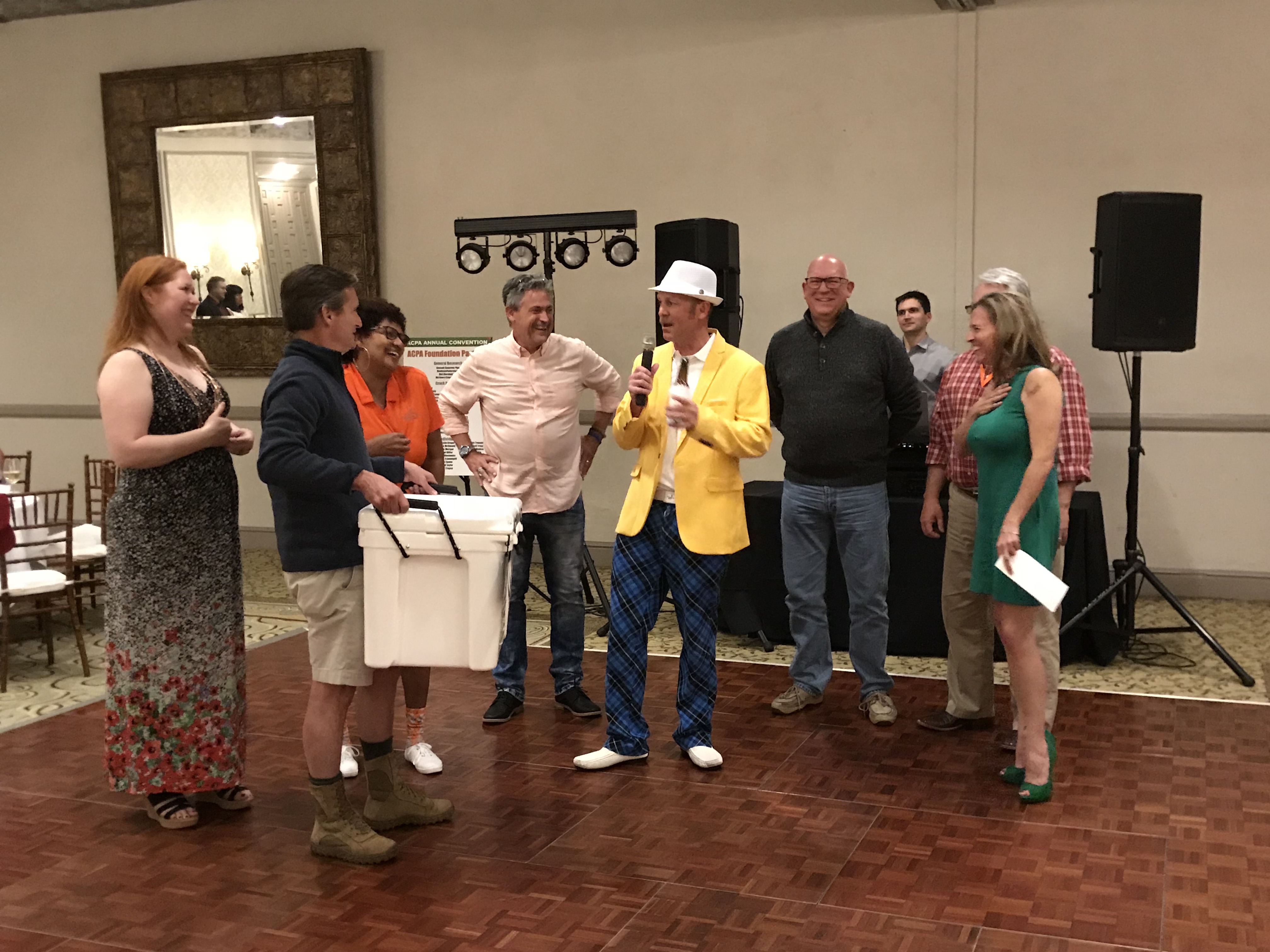
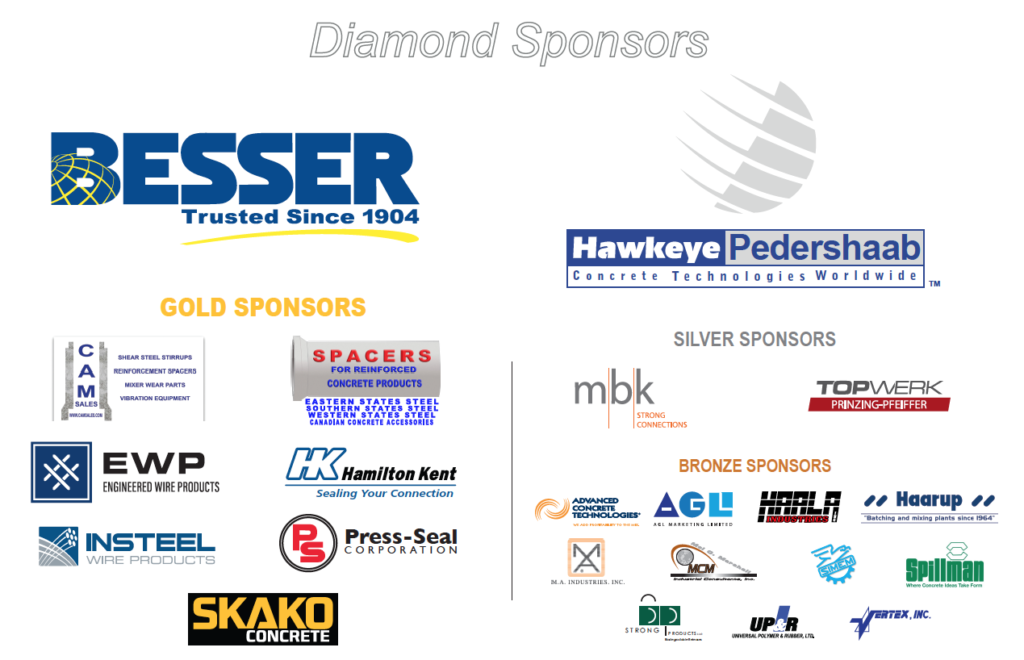

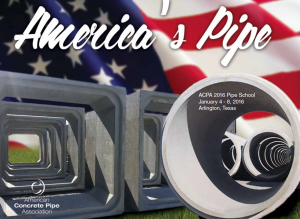
[…] American Concrete Pipe Association has put out an interesting paper on the benefits of using self-consolidating concrete (SCC) for a variety of pre-cast concrete […]